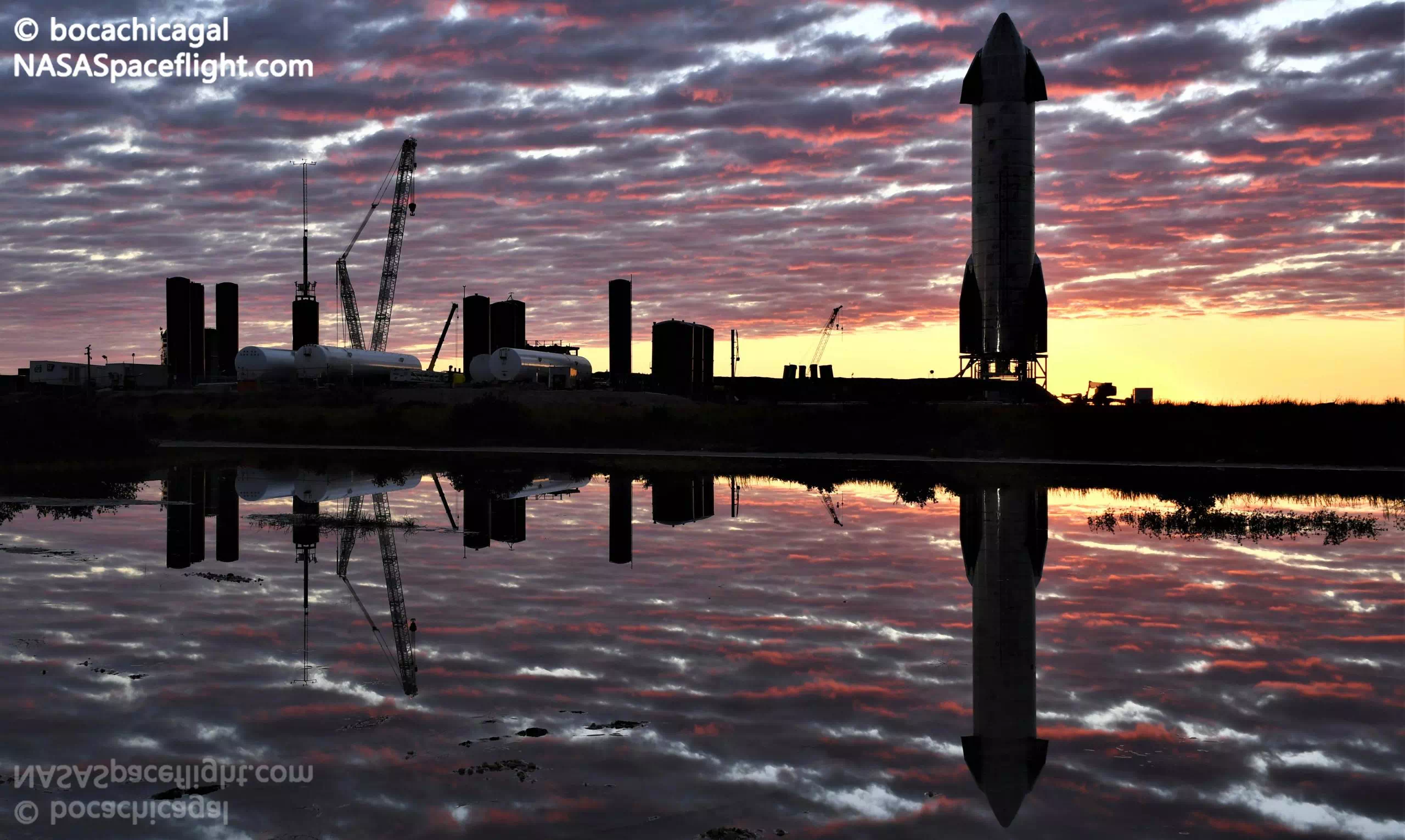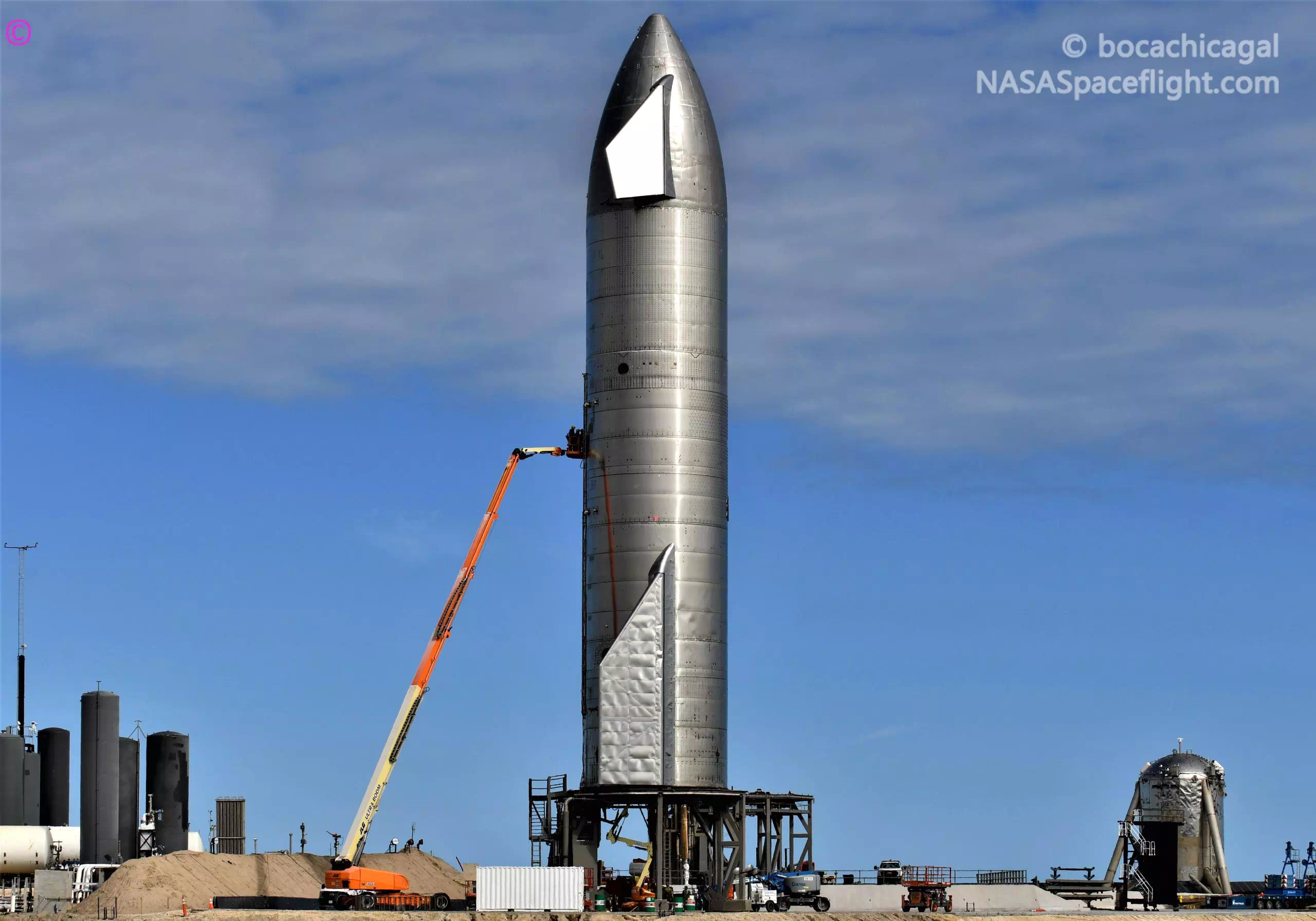
News
SpaceX schedules second Starship static fire after first test ends prematurely
Update: SpaceX appears to have plans for a second triple-Raptor static fire for Starship SN9 after the rocket’s first test was cut short for unknown reasons.
Identical to previous road closure windows, SpaceX will have an opportunity to test Starship SN9 from 8 am to 5 pm CST (UTC-6) on Friday, January 8th, potentially paving the way for a high-altitude launch attempt early next week if the second static fire goes as planned. Stay tuned for updates!
In what is likely one of the last steps before SpaceX’s next high-altitude Starship launch attempt, the company appeared to successfully put Starship serial number 9 (SN9) through its first triple-Raptor static fire test.
Relatively late into a test window that opened at 8 am CST (UTC-6) but was later pushed to noon, SpaceX’s first Starship SN9 static fire attempt began in earnest around 3:15 pm CST. Signified by venting activity at the propellant farm tasked with preparing and loading liquid oxygen and methane on Starships, slight tweaks in the test flow were observed but the static fire occurred more or less when expected at 4:07 pm.
SN9 ignited all three of its Raptors in quick succession and shut the engines down over the course of 1.5-2 seconds – extremely short relative to all previous nominal Starhopper or Starship-mounted Raptor static fires. Long-time followers immediately noted that small discrepancy, speculating that it could either have been a post-ignition abort or intentionally shortened to avoid damaging the pad’s concrete surface (an incident that’s occurred several times during recent tests).
Not long before the short static fire, SpaceX extended the end of its January 6th test window (in the form of road closure notices) from 5 pm to 8 pm. Oddly, rather than the expected response of detanking Starship and reopening the road after a successful test, SpaceX essentially recycled SN9 and began a separate test around 6 pm. The road was never reopened and a SpaceX team never headed back to the pad between the tests, implying that the company may have run into a minor hardware or software bug earlier in the day.
It’s unclear what the actual goal of the second attempt was and it’s more or less impossible to know for sure with confirmation from CEO Elon Musk. It’s possible – if unlikely – that the first static fire went exactly as planned and the follow-up test was meant to be a simple data-gathering wet dress rehearsal (WDR). Either way, after a surprise downpour briefly engulfed Starship SN9 minutes prior, the second test appeared to abort about 30 minutes into propellant conditioning and loading, precluding both a complete WDR and/or static fire.


According to a test notice received on January 6th by NASASpaceflight contributer and photographer Mary (bocachicagal), SpaceX has another test window available on January 7th in the event that Wednesday’s testing was partially unsuccessful. In a rare case, SpaceX’s hand-distributed warning for residents preceded any additional planned road closures, the last of which lifted on January 6th.
On January 5th, SpaceX received a trio of Temporary Flight Restrictions (TFRs) from the FAA that will allow the company to restrict access to nearby airspace for high-altitude Starship launch attempts on January 8th, 9th, and 10th. Lacking an unequivocally successful static fire, it’s highly unlikely – but not impossible – that Starship will be ready for a launch attempt during any of those three windows. Still, it’s safe to say that SN9 is probably less than a week away from its first flight – expected to be a carbon copy of SN8’s 12.5 km (7.8 mi) launch and landing attempt – if SpaceX can complete a full-duration static fire in the next day or two.
News
Tesla begins Robotaxi certification push in Arizona: report
Tesla seems serious about expanding its Robotaxi service to several states in the coming months.

Tesla has initiated discussions with Arizona transportation regulators to certify its driverless Robotaxi service in the state, as per a recent report from Bloomberg News. The move follows Tesla’s launch of its Robotaxi pilot program in Austin, Texas, as well as CEO Elon Musk’s recent comments about the service’s expansion in the Bay Area.
The Arizona Department of Transportation confirmed to Bloomberg that Tesla has reached out to begin the certification process for autonomous ride-sharing operations in the state. While details remain limited, the outreach suggests that Tesla is serious about expanding its driverless Robotaxi service to several territories in the coming months.
The Arizona development comes as Tesla prepares to expand its service area in Austin this weekend, as per CEO Elon Musk in a post on X. Musk also stated that Tesla is targeting the San Francisco Bay Area as its next major market, with a potential launch “in a month or two,” pending regulatory approvals.
Tesla first launched its autonomous ride-hailing program on June 22 in Austin with a small fleet of Model Y vehicles, accompanied by a Tesla employee in the passenger seat to monitor safety. While still classified as a test, Musk has said the program will expand to about 1,000 vehicles in the coming months. Tesla will later upgrade its Robotaxi fleet with the Cyercab, a two-seater that is designed without a steering wheel.
Sightings of Cybercab castings around the Giga Texas complex suggests that Tesla may be ramping the initial trial production of the self-driving two-seater. Tesla, for its part, has noted in the past that volume production of the Cybercab is expected to start sometime next year.
In California, Tesla has already applied for a transportation charter-party carrier permit from the state’s Public Utilities Commission. The company is reportedly taking a phased approach to operating in California, with the Robotaxi service starting with pre-arranged rides for employees in vehicles with safety drivers.
News
Tesla sets November 6 date for 2025 Annual Shareholder Meeting
The automaker announced the date on Thursday in a Form 8-K.

Tesla has scheduled its 2025 annual shareholder meeting for November 6, addressing investor concerns that the company was nearing a legal deadline to hold the event.
The automaker announced the date on Thursday in a Form 8-K submitted to the United States Securities and Exchange Commission (SEC). The company also listed a new proposal submission deadline of July 31 for items to be included in the proxy statement.
Tesla’s announcement followed calls from a group of 27 shareholders, including the leaders of large public pension funds, which urged Tesla’s board to formally set the meeting date, as noted in a report from The Wall Street Journal.
The group noted that under Texas law, where Tesla is now incorporated, companies must hold annual meetings within 13 months of the last one if requested by shareholders. Tesla’s previous annual shareholder meeting was held on June 13, 2024, which placed the July 13 deadline in focus.
Tesla originally stated in its 2024 annual report that it would file its proxy statement by the end of April. However, an amended filing on April 30 indicated that the Board of Directors had not yet finalized a meeting date, at least at the time.
The April filing also confirmed that Tesla’s board had formed a special committee to evaluate certain matters related to CEO Elon Musk’s compensation plan. Musk’s CEO performance award remains at the center of a lengthy legal dispute in Delaware, Tesla’s former state of incorporation.
Due to the aftermath of Musk’s legal dispute about his compensation plan in Delaware, he has not been paid for his work at Tesla for several years. Musk, for his part, has noted that he is more concerned about his voting stake in Tesla than his actual salary.
At last year’s annual meeting, TSLA shareholders voted to reapprove Elon Musk’s compensation plan and ratified Tesla’s decision to relocate its legal domicile from Delaware to Texas.
Elon Musk
Grok coming to Tesla vehicles next week “at the latest:” Elon Musk
Grok’s rollout to Tesla vehicles is expected to begin next week at the latest.

Elon Musk announced on Thursday that Grok, the large language model developed by his startup xAI, will soon be available in Tesla vehicles. Grok’s rollout to Tesla vehicles is expected to begin next week at the latest, further deepening the ties between the two Elon Musk-led companies.
Tesla–xAI synergy
Musk confirmed the news on X shortly after livestreaming the release of Grok 4, xAI’s latest large language model. “Grok is coming to Tesla vehicles very soon. Next week at the latest,” Musk wrote in a post on social media platform X.
During the livestream, Musk and several members of the xAI team highlighted several upgrades to Grok 4’s voice capabilities and performance metrics, positioning the LLM as competitive with top-tier models from OpenAI and Google.
The in-vehicle integration of Grok marks a new chapter in Tesla’s AI development. While Tesla has long relied on in-house systems for autonomous driving and energy optimization, Grok’s integration would introduce conversational AI directly into its vehicles’ user experience. This integration could potentially improve customer interaction inside Tesla vehicles.
xAI and Tesla’s collaborative footprint
Grok’s upcoming rollout to Tesla vehicles adds to a growing business relationship between Tesla and xAI. Earlier this year, Tesla disclosed that it generated $198.3 million in revenue from commercial, consulting, and support agreements with xAI, as noted in a report from Bloomberg News. A large portion of that amount, however, came from the sale of Megapack energy storage systems to the artificial intelligence startup.
In July 2023, Musk polled X users about whether Tesla should invest $5 billion in xAI. While no formal investment has been made so far, 68% of poll participants voted yes, and Musk has since stated that the idea would be discussed with Tesla’s board.
-

 Elon Musk1 week ago
Elon Musk1 week agoTesla investors will be shocked by Jim Cramer’s latest assessment
-

 Elon Musk3 days ago
Elon Musk3 days agoElon Musk confirms Grok 4 launch on July 9 with livestream event
-

 Elon Musk14 hours ago
Elon Musk14 hours agoxAI launches Grok 4 with new $300/month SuperGrok Heavy subscription
-

 News7 days ago
News7 days agoTesla Model 3 ranks as the safest new car in Europe for 2025, per Euro NCAP tests
-

 Elon Musk2 weeks ago
Elon Musk2 weeks agoA Tesla just delivered itself to a customer autonomously, Elon Musk confirms
-

 Elon Musk1 week ago
Elon Musk1 week agoxAI’s Memphis data center receives air permit despite community criticism
-

 Elon Musk2 weeks ago
Elon Musk2 weeks agoTesla’s Omead Afshar, known as Elon Musk’s right-hand man, leaves company: reports
-

 News2 weeks ago
News2 weeks agoXiaomi CEO congratulates Tesla on first FSD delivery: “We have to continue learning!”

















